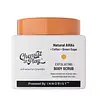What's inside
What's inside
 Key Ingredients
Key Ingredients

 Benefits
Benefits

 Concerns
Concerns

 Ingredients Side-by-side
Ingredients Side-by-side

Water
Skin ConditioningSodium Lauroyl Sarcosinate
CleansingCocamidopropyl Betaine
CleansingSodium Lauroyl Methyl Isethionate
CleansingAcrylates Copolymer
Glycol Stearate
EmollientPropanediol
SolventLactic Acid
BufferingCocamide Mea
EmulsifyingBetaine
HumectantSalicylic Acid
MaskingPhenoxyethanol
PreservativeParfum
MaskingTocopheryl Acetate
AntioxidantOryza Sativa
Sodium Astrocaryum Murumuruate
EmollientSodium Hyaluronate
HumectantOryza Sativa Cera
Skin ConditioningHydrolyzed Amorphophallus Konjac Root
HumectantPhospholipids
Skin ConditioningSphingolipids
EmollientSodium Hydroxide
BufferingDisodium EDTA
Water, Sodium Lauroyl Sarcosinate, Cocamidopropyl Betaine, Sodium Lauroyl Methyl Isethionate, Acrylates Copolymer, Glycol Stearate, Propanediol, Lactic Acid, Cocamide Mea, Betaine, Salicylic Acid, Phenoxyethanol, Parfum, Tocopheryl Acetate, Oryza Sativa, Sodium Astrocaryum Murumuruate, Sodium Hyaluronate, Oryza Sativa Cera, Hydrolyzed Amorphophallus Konjac Root, Phospholipids, Sphingolipids, Sodium Hydroxide, Disodium EDTA
Coffea Arabica Seed Powder
AbrasiveSucrose
HumectantSodium Chloride
MaskingSorbitol
HumectantJuglans Regia Shell Powder
AbrasiveTheobroma Cacao Husk
AbrasiveWater
Skin ConditioningSodium Cocoyl Isethionate
CleansingPrunus Amygdalus Dulcis Oil
Skin ConditioningDicaprylyl Carbonate
EmollientIsopropyl Palmitate
EmollientGlycerin
HumectantParfum
MaskingAstrocaryum Murumuru Seed Powder
AbrasiveOlea Europaea Fruit Oil
MaskingSodium Benzoate
MaskingPotassium Sorbate
PreservativeCocos Nucifera Oil
MaskingVaccinium Myrtillus Fruit/Leaf Extract
AstringentTocopheryl Acetate
AntioxidantSaccharum Officinarum Extract
MoisturisingCitrus Limon Fruit Extract
MaskingAcer Saccharum Extract
Skin ConditioningOryza Sativa Cera
Skin ConditioningCeramide Ag
HumectantPhospholipids
Skin ConditioningSphingolipids
EmollientCoffea Arabica Seed Powder, Sucrose, Sodium Chloride, Sorbitol, Juglans Regia Shell Powder, Theobroma Cacao Husk, Water, Sodium Cocoyl Isethionate, Prunus Amygdalus Dulcis Oil, Dicaprylyl Carbonate, Isopropyl Palmitate, Glycerin, Parfum, Astrocaryum Murumuru Seed Powder, Olea Europaea Fruit Oil, Sodium Benzoate, Potassium Sorbate, Cocos Nucifera Oil, Vaccinium Myrtillus Fruit/Leaf Extract, Tocopheryl Acetate, Saccharum Officinarum Extract, Citrus Limon Fruit Extract, Acer Saccharum Extract, Oryza Sativa Cera, Ceramide Ag, Phospholipids, Sphingolipids
Ingredients Explained
These ingredients are found in both products.
Ingredients higher up in an ingredient list are typically present in a larger amount.
We don't have a description for Oryza Sativa Cera yet.
Parfum is a catch-all term for an ingredient or more that is used to give a scent to products.
Also called "fragrance", this ingredient can be a blend of hundreds of chemicals or plant oils. This means every product with "fragrance" or "parfum" in the ingredients list is a different mixture.
For instance, Habanolide is a proprietary trade name for a specific aroma chemical. When used as a fragrance ingredient in cosmetics, most aroma chemicals fall under the broad labeling category of “FRAGRANCE” or “PARFUM” according to EU and US regulations.
The term 'parfum' or 'fragrance' is not regulated in many countries. In many cases, it is up to the brand to define this term.
For instance, many brands choose to label themselves as "fragrance-free" because they are not using synthetic fragrances. However, their products may still contain ingredients such as essential oils that are considered a fragrance by INCI standards.
One example is Calendula flower extract. Calendula is an essential oil that still imparts a scent or 'fragrance'.
Depending on the blend, the ingredients in the mixture can cause allergies and sensitivities on the skin. Some ingredients that are known EU allergens include linalool and citronellol.
Parfum can also be used to mask or cover an unpleasant scent.
The bottom line is: not all fragrances/parfum/ingredients are created equally. If you are worried about fragrances, we recommend taking a closer look at an ingredient. And of course, we always recommend speaking with a professional.
Learn more about ParfumPhospholipids are naturally found in our skin as they are the main component of cell membranes. Phospholipids have humectant, emollient, antioxidant properties.
Phospholipids are complex lipids that contain glycerin, two fatty acids, and a phosphate group. Some foods that contain phospholipids include soybeans and milk. The phospholipids found in soy come from Lecithin. This ingredient can also be synthetically created.
Due to their hygroscopic nature, they act as both humectants and emollients. Humectants draw moisture from the air to your skin, while emollients help trap moisture in.
The phospholipids in our skin can be naturally depleted. Replenishing the phospholipids in our skin can help hydrate your skin.
Studies show phospholipids display antioxidant activity and may help with reducing the signs of aging.
This ingredient is non-occlusive.
Some types of phospholipids:
Learn more about PhospholipidsSphingolipids are a major class of lipids in cell membranes. This ingredient has emollient, skin conditioning, and skin protecting properties.
Certain ceramides are considered sphingolipids (Ceramide NS and Ceramid AP), but not all sphingolipids are ceramides.
Tocopheryl Acetate is AKA Vitamin E. It is an antioxidant and protects your skin from free radicals. Free radicals damage the skin by breaking down collagen.
One study found using Tocopheryl Acetate with Vitamin C decreased the number of sunburned cells.
Tocopheryl Acetate is commonly found in both skincare and dietary supplements.
Learn more about Tocopheryl AcetateWater. It's the most common cosmetic ingredient of all. You'll usually see it at the top of ingredient lists, meaning that it makes up the largest part of the product.
So why is it so popular? Water most often acts as a solvent - this means that it helps dissolve other ingredients into the formulation.
You'll also recognize water as that liquid we all need to stay alive. If you see this, drink a glass of water. Stay hydrated!
Learn more about Water